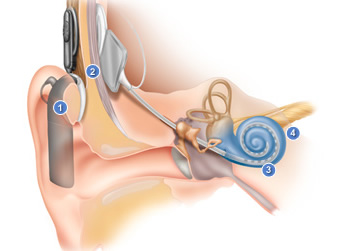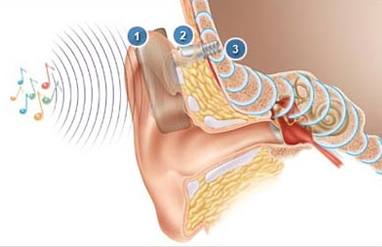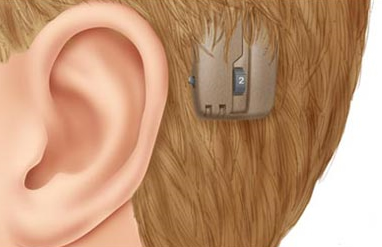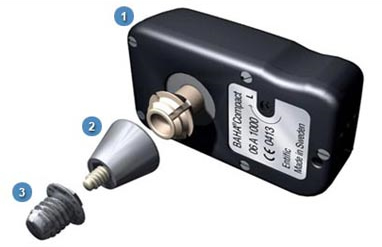Implantable Hearing Devices
Cochlear Implant
What is a Cochlear Implant?
If you want to expand communication options, or if hearing aids just aren’t enough, the time might be right to explore a cochlear implant. The Nucleus Freedom cochlear implant system can help connect you to a world of sound.
Simply put, a cochlear implant is a technological triumph. It's the only medical device designed to restore a human sense. It’s an alternative to traditional solutions like hearing aids, which often provide little or no benefit for someone with a severe-to-profound hearing loss.
The Nucleus Freedom cochlear implant system is comprised of a few different parts that work together to help you hear.
Everyone has a unique first experience with their cochlear implants. It’s important to remember that learning to hear with cochlear implants can be a gradual process for some, while others may understand new sounds right from the beginning. It can take time for the brain to adjust to this new way of hearing, so patience, practice and a positive attitude are important.
As part of our lifetime commitment, we offer rehabilitation tools and services to help you improve hearing, language, phone use and music appreciation.
Some of the benefits of cochlear implants include:
- Social Situations
- Many users may speak more clearly and understand speech more easily without relying on lip-reading.
- Music and Phone
- Many cochlear implant users can talk on the phone without the assistance of TTY or relay systems. Listening to music opens up a new world of enjoyment.
Environmental Sounds - Hear a wide array of important sounds like alarms, doorbells and approaching vehicles. Soak in the subtle sounds of nature, such as rain, birds singing or dogs barking.
How Natural Hearing Works:
1. Ear canal: Sound moves through the ear canal and strikes the eardrum.
2. Eardrum and bones: Sound waves cause the eardrum to vibrate, sending the bones in the middle ear into motion.
3. Inner ear: This motion causes the fluid inside the inner ear (cochlea) to move the hair cells.
4. Hearing nerve: Hair cells change the movement into electric impulses, which are sent to the hearing nerve into the brain; you hear sound.
How Nucleus Works:

1. Sound Processor: External sound processor captures sound and converts it into digital signals.
2. Digital Signals: Processor sends digital signals to internal implant.
3. Electrode Array: Internal implant converts signals into electrical energy, sending it to an electrode array inside the cochlea.
4. Hearing Nerve: Electrodes stimulate hearing nerve, bypassing damaged hair cells, and the brain perceives signals as sound.
Bone Anchored Hearing Aid (Baha Implant)
The Baha® System
Bone, like air, can conduct sound vibrations. For people with hearing loss, this provides another pathway to perceive sound. Typical hearing aids rely on air conduction and a functioning middle ear.
In cases where the middle ear function is blocked, damaged or occluded, the Baha system may be a better option as it bypasses the outer and middle ear altogether. Instead, sound is sent around the damaged or problematic area, naturally stimulating the cochlea through bone conduction. Furthermore, with unilateral deafness the Baha can be used to conduct sound from the deaf side to the hearing cochlea on the opposite side.
Once the cochlea receives these sound vibrations, the organ ‘hears’ in the same manner as through air conduction; the sound is converted into neural signals and is transferred to the brain, allowing a Baha recipient to perceive sound.

1. A sound processor picks up sound vibrations.
2. An abutment is attached to the sound processor and the implant. The abutment transfers the sound vibrations from the processor to the implant.
3. A small titanium implant is placed in the bone behind the ear where it fuses with the living bone. This process is called osseointegration. The implant transfers the sound vibrations to the functioning cochlea.
The Baha® system is unique in the world of hearing treatments
The Baha system utilizes Direct Bone Conduction, which allows the bone to transfer sound to a functioning cochlea – thereby bypassing the outer and middle ear. This unique hearing treatment is the first system of its kind cleared by the Food and Drug Administration (FDA) to treat hearing loss.
One reason the Baha system works so well is due to its simple design. The Baha system combines a sound processor with an abutment and a small titanium implant. The implant is placed behind the non-functioning ear. Surgery is minor, and Baha recipients report a wide range of advantages over other hearing devices.

After a period of approximately three months (six months for children) the implant will have osseointegrated with the bone. The sound processor may now be attached to the abutment, enabling the recipient to hear with the Baha® system fully in place for the first time.
The audiologist will explain the various functions of the sound processor, and will demonstrate the technique necessary for removal and fitting of the processor.
Connecting and disconnecting the sound processor is very simple. A plastic snap is mounted to the sound processor. It is designed to snap into the abutment and hold the sound processor securely in place.

Why People Choose Baha?
One of the benefits of choosing Baha is that you can ask your hearing care professional for a Baha demonstration, so you can hear the difference yourself. Many people are surprised by the amount of hearing improvement that the Baha delivers.
These are some of the top reasons why people make the decision to go with Baha.
- Direct Bone Conduction allows the recipient to hear sounds more clearly and naturally.
- Potential recipients can easily test the Baha so that they can experience the benefits before they have surgery.
- The Baha is comfortable to wear; recipients say that they forget that they have it on.
- The Baha is in use by thousands of individuals around the world. The outcomes are predictable and well documented.
- The Baha procedure is reversible and does not damage or harm residual hearing.
Additionally, the Baha system does not preclude any benefits from future hearing technological advances because it doesn’t compromise middle or inner ear or compromise hearing nerve sensitivity.
